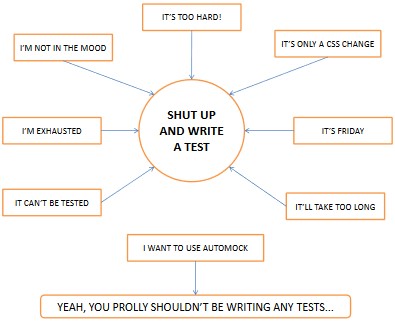Should I Write a Test?
Around ten years ago I stumbled upon a diagram if and when to write a test. This was a repeating question in trainings, when should you write tests? Before or after writing the code? Only when you have time? Only when you feel like it? I loved the diagram because there was only one end state. Whatever the reason or excuse would be, just shut up and write a test! It does not matter if you are tired, or if it is a little change, it should be tested. Such a rule is helpful when you want to adopt Test Driven Development, as there are plenty of excuses why to skip it.

The original diagram was created by Gemma R Cameron, a software engineer and event organiser from Manchester. She was inspired by a similar diagram about skating. Recently, when I was asked again when to test, I wanted to share the diagram and could not find its page. I thought it lost and planned to repost the diagram here. Eventually I discovered Gemma's page again, it had moved from a
.me to a WordPress domain. I am glad that the original source is still available. You can find it here.Java Version
The original version of the diagram was for Ruby, indicated by the use of Automock. What was bad with Automock? It provided some support for automated mocking of Rails application and is dead since 2016. Here I present a slightly modified version for Java, replacing Automock with PowerMock. And I do know what is wrong with PowerMock. It is a powerful mocking tool which uses a custom class loader and bytecode manipulation to enable mocking of static methods, constructors, final classes and methods, private methods and more. It is useful to bring legacy code under test, before seams can be introduced. The bytecode manipulation makes it slow compared to regular mocking. If used often, the whole test suite will run much longer than needed. Further, if code is hard to test, I change its design to make it testable by applying SOLID principles or by creating seams as outlined by Michael Feathers in his WELC book. Using PowerMock for tests does not improve the design. (I am not inherently against PowerMock, it is extremely powerful and as such dangerous. I needed something to replace Automock.)
Download and print the Java version of the Shut up and Write a Test Diagram. The fact that there are versions of this diagram for both Ruby and Java is a testament to the universality of its principle: Shut up and Write a Test! The Code Cop approves, and I am sure your future self will too.








No comments:
Post a Comment